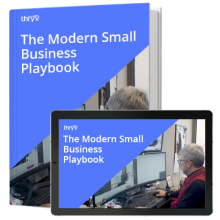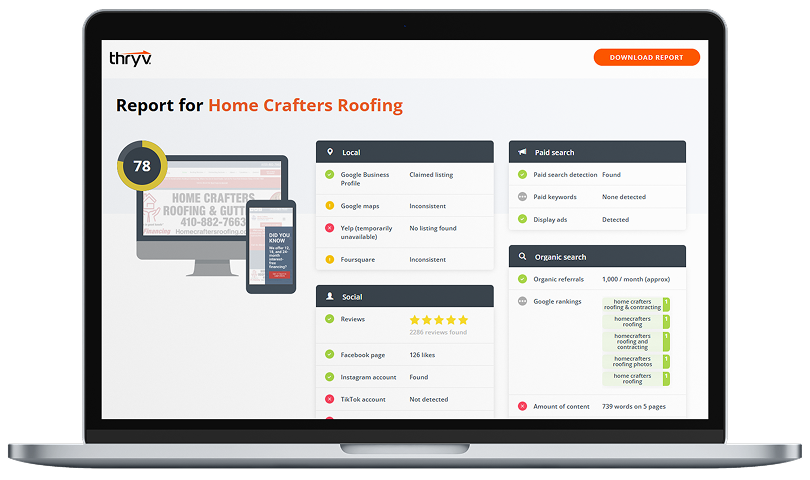Marketing for small businesses can feel like an uphill battle. You might think you don’t have enough resources, or that starting an effective marketing plan is too complicated. Add on an entire day’s work, and it’s easy for your marketing strategy to fall behind while you focus on other tasks.
But that’d be a huge missed opportunity for your business. Small businesses rely on marketing to attract new customers and keep existing ones happy with their brand.

Free Guide: Modern Small Business Playbook
In this guide, we’ll show you how to modernize your business with the right tools.
Save NowIn this post, we’ll discuss marketing 101. We’ll cover what you can do as a small business owner and which marketing channels you should use to position your brand for success.
What is Marketing 101?
Marketing 101 refers to the basics of marketing, which includes creating, promoting, and delivering products. These fundamental principles help you create an effective marketing plan for your business.
So, what is marketing 101? Let’s dive in.
Marketing is any action you take to promote your products or services. Its goal is to spread the word about your company to existing and potential customers.
Ultimately, marketing should:
- Build brand awareness.
- Bring in new customers.
- Delight current customers so they keep coming back for more.
For any marketing campaign, the first place to start is setting goals. Just like creating a business plan, you need to know your short- and long-term objectives. Then, you need a deep understanding of your target audience to build an effective marketing message.
If I had to define marketing 101 in one sentence, it would be to know your target audience deeply. To market your product or service, you must know your audience. You need to know who they are, how they feel, their pain points, and their goals.
For example, we’ve gone over the 4 P’s of marketing (product, price, place, promotion) in this post, but I want to reiterate two points here:
- If you don’t know your audience, you won’t be able to explain your product or service’s value accurately.
- To promote your product, you must know where your audience is. Then, you can market to them there.
Once you know your goals and your audience, it’s time to choose your marketing channels. You’ll also need a way to measure your strategy’s effectiveness so you can adapt your campaigns based on your results.
So, what have we learned? To create a marketing plan, you should get started with the basics:
- Know your goals.
- Have a deep understanding of your target audience.
- Decide which marketing channels to use (find where your target audience spends time, online or in-person).
- Determine the metrics you’ll use to measure your strategy.
- Adapt based on the results.
WATCH OUR VIDEO: Debunking Marketing Automation Myths
As you go through these steps, you might have questions about how to create a marketing plan. Below, we’ll go over our top tips for small businesses that are just getting started.
How can I market my small business?
- Write out your marketing goals.
- Conduct market research.
- Create an ideal customer profile.
- Build your brand identity.
- Choose your marketing channels.
- Keep in mind the customer journey.
- Use data to adapt your strategy.
- Consider outbound marketing strategies.
- Evaluate your product and reputation.
- Always have a call to action.
1. Write out your marketing goals.
The best way to start marketing your business is to write down your goals. Remember, your goals should be SMART (specific, measurable, attainable, relevant, and time-bound). You want them to be explicit and clearly stated. After defining each goal, you should also list the marketing channels you’ll use to achieve it.
Here are some examples of SMART goals and marketing channels you can use for your plan:
| Business Goal | Smart Goal | Marketing Channels |
| Increase brand awareness. | Increase brand awareness by 30% in the next 12 months. |
Use social media, community partnerships, and content marketing to reach a wider audience. |
| Get more customers. | Gather 1,000 new emails per business quarter. | Create blog content and downloadable resources (e.g., templates, eBooks, checklists) |
| Boost website traffic. | Increase website traffic by 25% within 6 months. | Search engine optimization (SEO) – including keyword research, blogging, technical SEO, and local SEO |
| Engage more customers. | Increase social media engagement (likes, shares, comments) by 50% in 6 months. | Post more interactive content, like polls and videos. Also, engage with the audience in comments and messages. |
| Retain your most valuable customers. |
Increase customer retention rates by 15% in the next year. |
Launch a loyalty program, send personalized emails, and improve customer support. |
| Attract more customers to your business. | Get 500 new customers per quarter through digital marketing channels. | Use targeted ads, referrals, and special offers to attract new customers. |
| Build your email subscriber list. | Grow my email subscriber list by 25% within 6 months. |
Use website pop-up forms, exclusive content, and social media promotions to boost sign-ups. |
| Improve content marketing performance. | Increase blog readership by 40% over the next year. |
Create high-quality, in-depth content. Promote posts on multiple channels. Use SEO to rank higher on search engines. |
| Boost brand reputation. |
Improve brand perception by 15% in 6 months. |
Improve customer service. Respond to reviews. Create campaigns that reinforce brand values. |
WATCH OUR VIDEO: Small Business SEO Tips from Google
2. Conduct market research.
Once you know your goals, you should begin market research. Market research will help you:
- Understand the best ways to reach customers.
- Create value with your marketing materials.
- Build loyalty with your customers.
- Learn what makes your product unique among competitors.
Before you get started, there are two types of market research:
- Primary: Surveys and interviews conducted by your company.
- Secondary: Existing data and statistics.
It’s best to have a mix of both primary and secondary data.
WATCH OUR VIDEO: Why First Party Reviews are so Important
Market research helps you understand your target audience, including their demographics, consumer behavior, and buying patterns.
If it sounds like psychology 101, it’s because marketing is, in many ways, based on human behavior. It’s knowing how to position your product properly to your customer base. When you think about marketing, remember this: It’s sending the right message to the right person at the right time. Market research will help you do just that.
3. Create an ideal customer profile.
After conducting market research, define your ideal customer. Identify the best person to buy your products and what that person is like. This could be a general description or a life story that gives the customer a name, background, and persona. The more descriptive you are, the easier it will be to craft effective campaigns for your business.
Your business may have a few of these personas. They make up what’s called your “target audience.” You can tag these groups in your CRM using customer segmentation. Customer segmentation is the process of organizing your customers into groups so you can market to each one.
For example, if you own an HVAC company, targeting first-time homeowners versus home developers will affect how you position your products and services. I think about it this way: When I talk to coworkers, friends, and family, I talk to each group differently. Similarly, customer profiles will help you write marketing messages based on the intended audience.

Modern Small
Business Playbook
Find expert tips and tools to help you streamline communications, automate your marketing efforts, improve your business operations, and more in this free guide.
4. Build your brand identity.
Your brand identity is how your company is perceived. It includes a visual identity, like logos, color palettes, and font styles, and a unique brand voice that personifies your company.
You need a clear personality and a distinct point of view to build a brand identity. At this point, you might be wondering, “Why do I need to do this?” The best answer is that people want to buy from people – not faceless corporations focused on making money. These days, your company values are more important than ever because they help distinguish your business from big-box brands.
Creating your brand identity is only half the battle. After that, you’ll use your brand as a guideline for every marketing asset you create. Ask yourself:
- Does this messaging align with our values?
- Does this marketing campaign communicate who we are?
- Is this social media post written from our brand’s point of view? In our voice?
5. Choose your marketing channels.
Now that we know who we are and who we’re marketing to, it’s time to decide which channels we’ll use to send our messages. Both digital and in-person (sometimes known as traditional) platforms are available. Online channels include social media, content marketing, local listings, email marketing, and display ads. In-person channels are billboards, print ads, direct mail, merchandise, and commercials.
Below, let’s review the must-have channels to include in your marketing plan.
Must-Have Marketing Channels
- Social Media: Choose the top 2-3 sites where your target audience is most active.
- Email: Email has a return on investment (ROI) of $36 for every $1 spent. Monthly newsletters with discounts are especially helpful.
- Website: Websites make it easier to find your business online. They also give you a platform where you can promote deals and messages.
- Display Ads: You should advertise through search engines and social media to reach more people.
- Business Listings: Business listings are contact points like your Google Business Profile and Yelp Business Page. This post shows you all the sites where you can create a local listing for your business.
- Direct Mail: ROI can be as high as 161% for customer lists.
- Customer Reviews: Ask customers for honest feedback. Then, you should respond to all reviews (not just the positive ones) to show you take feedback seriously.
6. Keep in mind the customer journey.
When you’re creating a marketing plan, it’s important to remember the journey that a customer goes through before making a purchase. This is often called the marketing funnel.
A person goes through these phases in the buying journey:
- Awareness: Potential customers become aware of your company.
- Consideration: When they’re considering their options, your marketing can help convince them that you’re the best one.
- Conversion: At this point, a potential buyer turns into a customer. Marketing materials for this stage must delight your customers so they become loyal and tell others about your company.
This entire process is often referred to as the customer journey. When creating marketing campaigns, it’s important to remember which stage you’re creating them for. You’ll develop different marketing materials to move people from one stage to the next.
7. Use data to improve your strategy.
Before you begin any marketing campaign, you should decide how to measure its success. The best way to do this is with data.
That data could be:
|
|
These are called “metrics,” which tell you how your marketing campaigns perform. You can use this information to adjust your strategy and improve your marketing messages over time.
Marketing software for your business can help here. Most tools have built-in reporting features that track these metrics for you. It saves you time and provides accurate breakdowns of your campaign’s performance.
Remember: Data (while very important) might only tell part of the story, but it will give you a better understanding of your audience and how they react to your marketing campaigns.
8. Consider offline marketing strategies.
Marketing a small business includes more than digital advertising. Small businesses need to be active in their local communities because this greatly affects their reputation. The more involved you are, the more loyal customers will be to your business.
One way to do this is to host events. Events help you gain immediate exposure to potential customers in your community. Hosting events that align with your company (like cooking workshops for a food-based company) will increase brand awareness and lead to more deals.
Here’s an example of an event hosted by a brewery. This brewery hosts all types of cooking classes to attract customers back to its taproom.
You should also attend or sponsor community events because it shows that you support other businesses in your area. Events like National Small Business Week are a great place to network and meet other small business owners. These events also allow you to showcase different products and gather feedback from experts with relevant experience. They provide an opportunity to discuss your business and increase awareness in B2B settings.
9. Evaluate your product and reputation.
One aspect of marketing that many businesses don’t consider is that it’s not a one-way conversation. Marketing is all about listening to your customers and adapting based on their feedback. Why do some customers leave? Why do some customers choose not to purchase from you? The answers to these questions will change how you do business and how you market your product or service.
The best way to get feedback is to:
- Conduct surveys regularly that ask your customers if they’re happy with you.
- Evaluate your ratings and reviews.
- Use your product or service data to evaluate product quality.
Ultimately, marketing will not help your business if the product or service doesn’t deliver. The best marketing strategy is to have a truly fantastic product that works and does what it’s supposed to (like relieving your customers’ pain points). When people look at reviews, they want to know that your product works and will solve their problems.
Remember: Most consumers check reviews before making purchases, and many will look for positive reviews before buying from your company.
10. Always have a call to action.
The question I sought to answer in this blog post was, “How can I market my small business?” By this point, I hope I’ve answered that question, but to boil it down further, all you need to know is this: Include a call to action on every marketing asset you create.
Tip: A call to action is the action marketers want audiences to take after consuming a piece of marketing material. This could be “Subscribe Now” or “Sign Up Here.”
When creating a marketing asset, remember why you’re doing it. What action do you want the customer to take? Do you want them to like, comment, make a purchase, leave a review, or something else? Whatever action you want them to take next needs to be explicit. Marketing is just like any form of communication – you must be clear about what you want someone to do and explain how it will benefit them.
Get Started With Small Business Marketing
At the beginning of this post, I said it would be a mistake to look at marketing as a complicated uphill battle that isn’t worth the effort. The reason is that there are simple, basic marketing strategies you can implement that will help you increase brand awareness and bring in new customers. For any company to have longevity, you need to work at getting the word out about who you are and what you do.

Modern Small
Business Playbook
Find expert tips and tools to help you streamline communications, automate your marketing efforts, improve your business operations, and more in this free guide.


